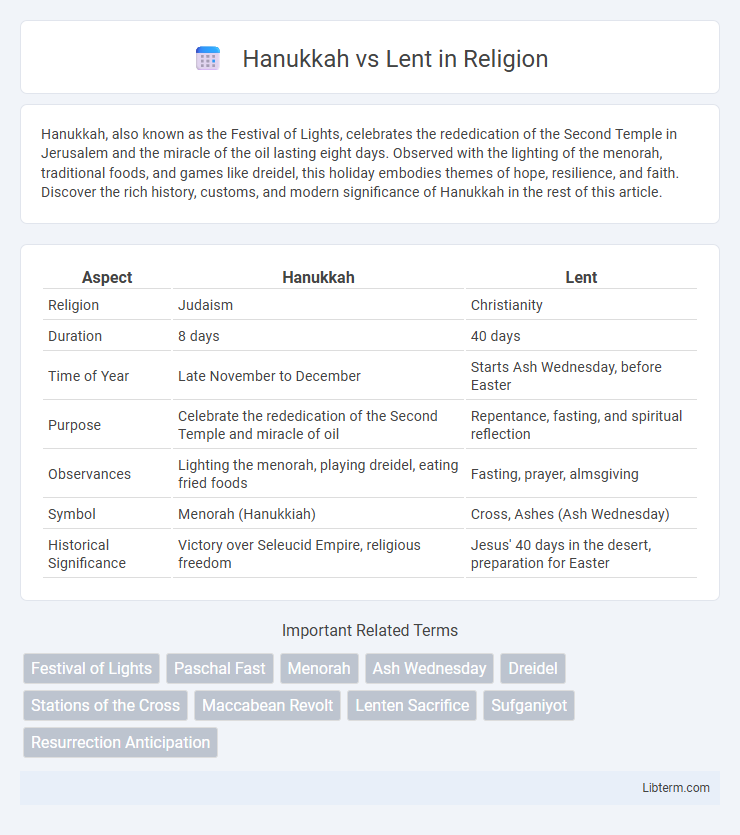Hanukkah, also known as the Festival of Lights, celebrates the rededication of the Second Temple in Jerusalem and the miracle of the oil lasting eight days. Observed with the lighting of the menorah, traditional foods, and games like dreidel, this holiday embodies themes of hope, resilience, and faith. Discover the rich history, customs, and modern significance of Hanukkah in the rest of this article.
Table of Comparison
| Aspect | Hanukkah | Lent |
|---|---|---|
| Religion | Judaism | Christianity |
| Duration | 8 days | 40 days |
| Time of Year | Late November to December | Starts Ash Wednesday, before Easter |
| Purpose | Celebrate the rededication of the Second Temple and miracle of oil | Repentance, fasting, and spiritual reflection |
| Observances | Lighting the menorah, playing dreidel, eating fried foods | Fasting, prayer, almsgiving |
| Symbol | Menorah (Hanukkiah) | Cross, Ashes (Ash Wednesday) |
| Historical Significance | Victory over Seleucid Empire, religious freedom | Jesus' 40 days in the desert, preparation for Easter |
Introduction to Hanukkah and Lent
Hanukkah, an eight-day Jewish festival, commemorates the rededication of the Second Temple in Jerusalem and the miracle of the oil lasting eight days. Lent, observed by Christians, is a 40-day period of fasting and repentance leading up to Easter, symbolizing Jesus Christ's sacrifice and resurrection. Both traditions involve significant religious rituals and spiritual reflection within their communities.
Historical Origins of Hanukkah and Lent
Hanukkah originates from the Maccabean Revolt in 167 BCE, celebrating the rededication of the Second Temple in Jerusalem after its desecration by Antiochus IV Epiphanes. Lent traces its beginnings to early Christian practices in the 4th century CE as a 40-day period of fasting and penance leading up to Easter, symbolizing Jesus Christ's 40 days of fasting in the wilderness. Both observances reflect significant historical and religious events that shaped Jewish and Christian liturgical traditions respectively.
Core Religious Significance
Hanukkah commemorates the rededication of the Second Temple in Jerusalem and the miracle of the oil that burned for eight days, symbolizing faith and divine intervention in Jewish tradition. Lent is a Christian observance marking the 40 days of fasting and repentance leading up to Easter, focusing on Jesus Christ's sacrifice and resurrection. Both periods emphasize spiritual reflection, but Hanukkah celebrates deliverance and miracle, while Lent centers on penitence and renewal.
Key Rituals and Practices
Hanukkah rituals center around lighting the menorah for eight nights, symbolizing the miracle of the oil, alongside playing dreidel and eating foods fried in oil like latkes and sufganiyot. Lent practices involve fasting, prayer, and abstaining from certain foods for 40 days to commemorate Jesus Christ's sacrifice and preparation for Easter. Both observances emphasize spiritual reflection but differ in expression, with Hanukkah focusing on celebration and light, while Lent prioritizes penitence and self-discipline.
Hanukkah Symbolism vs Lent Symbolism
Hanukkah symbolism centers on the menorah, which represents the miracle of the oil burning for eight days in the Second Temple, highlighting themes of light, hope, and divine intervention. Lent symbolism emphasizes the cross, ashes, and fasting, reflecting themes of repentance, sacrifice, and spiritual renewal in preparation for Easter. Both traditions use these symbols to convey deeper theological messages and guide followers through periods of reflection and celebration.
Foods and Dietary Traditions
Hanukkah features traditional foods fried in oil, such as latkes (potato pancakes) and sufganiyot (jelly-filled doughnuts), symbolizing the miracle of the oil lasting eight days in the Temple. Lent involves fasting and abstaining from meat, emphasizing simple meals like fish, vegetables, and bread to promote spiritual reflection and penance over 40 days. Both observances highlight food as a meaningful expression of cultural and religious identity through distinct dietary customs and restrictions.
Family and Community Involvement
Hanukkah fosters family and community involvement through shared rituals like lighting the menorah, playing dreidel, and exchanging gifts, which strengthen bonds and cultural identity. Lent emphasizes collective reflection and spiritual growth, encouraging families and communities to engage in prayer, fasting, and charitable acts together. Both observances cultivate a sense of unity and support, though Hanukkah leans toward celebratory traditions while Lent prioritizes introspective practices.
Duration and Timing on the Calendar
Hanukkah lasts for eight days, typically occurring in late November to December according to the Hebrew calendar, beginning on the 25th of Kislev. Lent spans approximately 40 days, starting on Ash Wednesday and ending on Holy Saturday, usually falling between February and April in the Gregorian calendar. The timing of Hanukkah is fixed based on the lunar Hebrew calendar, while Lent's timing varies each year depending on the date of Easter.
Modern Adaptations and Observance
Hanukkah has evolved into a vibrant celebration featuring menorah lightings, gift exchanges, and community gatherings that emphasize religious freedom and cultural identity. Lent, traditionally observed through fasting, prayer, and penance, has seen modern adaptations such as charitable giving, digital devotionals, and mindful reflection to fit contemporary lifestyles. Both holidays reflect evolving practices that balance historical customs with present-day expressions of faith and community engagement.
Hanukkah and Lent: Interfaith Perspectives
Hanukkah, an eight-day Jewish festival commemorating the rededication of the Second Temple and the miracle of the oil, emphasizes themes of light, resilience, and religious freedom. Lent, a 40-day Christian season of fasting, prayer, and repentance leading up to Easter, centers on spiritual reflection and renewal. Interfaith perspectives highlight how Hanukkah's celebration of historical perseverance complements Lent's introspective journey, fostering mutual respect and deeper understanding between Jewish and Christian communities.
Hanukkah Infographic

 libterm.com
libterm.com